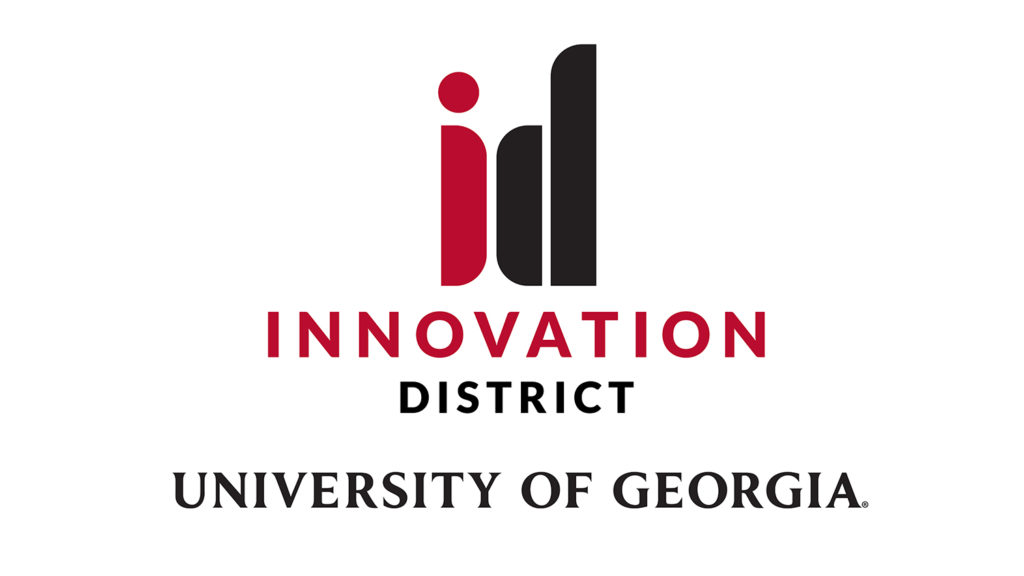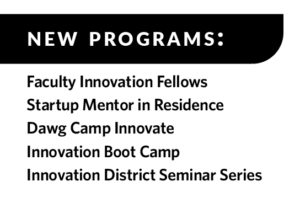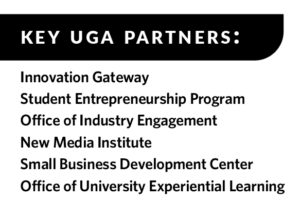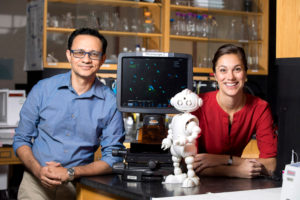Quietly and over several years, the University of Georgia has become a hotbed for innovation and entrepreneurship.
Take the team of students who built a tissue box-sized satellite to monitor the health of Georgia’s coastline from space. Or assistant professor Hitesh Handa, who is creating coatings to make medical devices safer. Take geology professor Valentine Nzengung, who invented chemical products that can neutralize discarded weapons and explosives, turning them into a nonhazardous waste. Or recent graduate Kaitlin Lutz BBA ’19, who started the web platform New Crew to help contractors find skilled workers and grow their businesses. There are still dozens of other student and faculty teams starting new ventures based on their ideas and university research.
And then there are the numbers. Among U.S. universities, UGA ranked No. 1 for new products to market in 2017, and for 11 straight years, UGA has been in the top 10 for new licenses and options based on faculty research. Add to that an explosion in student entrepreneurship through the Entrepreneurship Certificate Program and other experiential learning activities.
 At its best, this activity can take great ideas discovered and developed at UGA and turn them into something tangible, something that can benefit society, something that can promote economic growth. To connect this activity and amplify it, the university has launched the Innovation District initiative: a vision for a dynamic ecosystem of places, programs, and people all working together to foster innovation, entrepreneurship, and experiential learning.
At its best, this activity can take great ideas discovered and developed at UGA and turn them into something tangible, something that can benefit society, something that can promote economic growth. To connect this activity and amplify it, the university has launched the Innovation District initiative: a vision for a dynamic ecosystem of places, programs, and people all working together to foster innovation, entrepreneurship, and experiential learning.
“The future of this state and our nation depends on our ability to find answers to pressing challenges, to develop new technologies and businesses that strengthen our communities and our economy, and to prepare our students for the future,” says President Jere W. Morehead JD ’80. “The Innovation District, when fully developed, will do just that, and we are excited about the early progress of this initiative.”
Programs
The promise of the Innovation District began with grassroots programs. The Office of Research’s Innovation Gateway is leading the way for UGA technology transfer and faculty startup formation, and the Student Entrepreneurship Program offers courses and experiential learning opportunities for students wanting to test their startup ideas.
 Other programs, such as the New Media Institute and FABricate, are promoting innovative thinking in a particular field. These opportunities range from semester-long projects that bring students together with industry partners to intensive accelerator programs that help faculty members and students develop business plans to take their ideas to market.
Other programs, such as the New Media Institute and FABricate, are promoting innovative thinking in a particular field. These opportunities range from semester-long projects that bring students together with industry partners to intensive accelerator programs that help faculty members and students develop business plans to take their ideas to market.
Three years ago, UGA became the largest university in the nation to make experiential learning a requirement for graduation. The Innovation District is expanding this effort by creating opportunities for companies and startups to engage with students through project-based learning.
Partnerships
While each of these programs is thriving on their own, the vision for the ecosystem is to get them to work together, says Kyle Tschepikow PhD ’12, assistant to President Morehead and the lead for the district initiative. The idea is to bring creative people together from a variety of backgrounds and spark new ideas and collaborative ventures.
 “We believe a cohesive innovation ecosystem is a stronger innovation ecosystem, so we’re trying to find ways to coordinate more effectively among the many components and assets already in place at UGA,” says Tschepikow, who works with an 18-member launch team, with representatives from areas across campus, along with faculty input and an external advisory board that provides community and industry insights on the initiative.
“We believe a cohesive innovation ecosystem is a stronger innovation ecosystem, so we’re trying to find ways to coordinate more effectively among the many components and assets already in place at UGA,” says Tschepikow, who works with an 18-member launch team, with representatives from areas across campus, along with faculty input and an external advisory board that provides community and industry insights on the initiative.
Since the Innovation District Initiative launched in 2018, the university has introduced a new menu of programming to enrich the ecosystem. For example, this fall UGA named former Chick-fil-A executive and serial entrepreneur David Salyers BBA ’81 UGA’s first startup mentor-in-residence, providing guidance and encouragement to student and faculty entrepreneurs. The new Faculty Innovation Fellows program selects promising researchers and provides specialized resources and mentorship to nurture their entrepreneurial spirit.

The challenge will be to foster coordination among these various programs without undermining what’s made them so successful up to this point. Part of that conversation is making sure administrative barriers are not stopping UGA innovators from following through with good ideas.
The Campus of the Future
Currently, the beginning stages of the physical Innovation District are developing along Broad Street, where downtown Athens and UGA’s campus meet. Here, the organizers believe, the district can thrive as a magnet for startup formation and economic development alongside the Classic City’s vibrant art, music, and food scene.
Looking ahead, the university has designated other areas near North Campus and downtown for future development for the district when the demand and opportunity arise.
But Tschepikow emphasizes that this initiative goes beyond an area with specific borders. “The Innovation District is more than a place or set of buildings,” he says. “It’s an ecosystem that will reach across campus and across town, and at the same time, it’s a diverse community of creators, innovators, and entrepreneurs, all who want to see their ideas make a positive impact on the world around us.”
Ultimately, the aspirations for the Innovation District go beyond the university’s physical campus and even its faculty and students. Because the district’s goal is to make UGA ideas impactful, developing partnerships internally and externally is essential for success. The university is actively looking for potential partnerships with outside businesses and community organizations that can benefit from UGA research and student-led projects—and help students and faculty ideas reach their potential.


